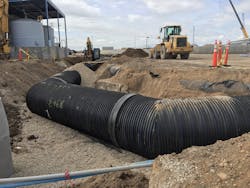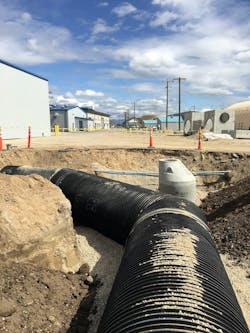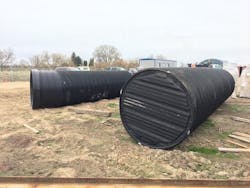Expanding Meridian With Secondary Clarifiers
Rian A. McCaslin is pipe area manager for Contech Engineered Solutions LLC. McCaslin can be reached at [email protected].
undefinedMunicipal and industrial wastewater management, storage and treatment presents owners and project designers with many challenges. From the laterals connecting residential, commercial and industrial facilities to the collection system to final treatment and discharge, wastewater’s corrosive properties and the environmental costs of leakage require piping systems that provide long service life and watertight joints. Therefore, it is extremely important to find solutions that will meet the industry’s demands with high performance and ideal service life at cost points that can fit within constrained budgets.
One such location, the Meridian Wastewater Resource Recovery Facility located in Idaho, is the central treatment plant for the city of Meridian. Over the past several years, the city had experienced substantial growth in population. To keep up with the growing demands in utilities due to an expanded population, Meridian’s wastewater division had to hire more than 20 new full-time employees over the past few years. Additionally, the volume of wastewater flow processed in Meridian had doubled since 2003, reaching more than 7.2 million gallons per day (mgd). To address both the increase in flow and new federal discharge permit requirements, Meridian began the process of expanding its water resource recovery facility.
As a part of the facility’s expansion, Meridian added two secondary clarifiers, referred to as 6 and 7. This required a large diameter pipe to convey the water. The discharge from each clarifier required 36-inch, 48-inch and 66-inch pipes to convey the flow to tertiary treatment prior to discharge to the creek.
Designing Around Proper Pipe
During the design phase of the 66-inch low-pressure line, reinforced concrete pipe (RCP) was originally specified. DuroMaxx steel reinforced polyethylene (SRPE), manufactured by Contech Engineered Solutions, was approved for the 66-inch line by the Meridian under a value engineering proposal for cost savings, lighter weight and long pipe lengths.
This SRPE combines the strength of steel with the durability of pressure rated polyethylene to provide a strong and durable pipe. The steel used in the pipe wall is 80-ksi and provides for 100% of the load carrying capacity of the composite pipe structure. Hydrostatic design basis (HDB) testing on the resin verifies important 50-year and 100-year design properties. Together with the 80-ksi steel, the HDB resin provides the designer and the owner with peace of mind from the structural, hydraulic, service life and low maintenance perspective. Available in sizes from 30-inches to 120-inches, the SRPE pipe has two jointing options: steel-reinforced bell and spigot joints, or welded joints. Picking between these depends on the diameter and project requirements. Standard lay lengths are 14 feet and 24 feet, but special lengths are frequently used. This SRPE pipe is ideal for storm sewer, sanitary sewer, pipeline rehabilitation, irrigation, and containment tanks.
The final design included an SRPE pipe solution for the 66-inch piping into to these two new clarifiers and provided some advantages. The lighter pieces were easier to install and were manufactured in longer segments, some as long as 48 feet. The design also required long radius curves, which are typically assembled by the installing contractor by cocking the joints. This is done by creating an inch spacing on one side of the bell and spigot joint while the other side is flush. Done correctly, this allows the contractor to manufacture curves in the pipe. Done incorrectly, this can be a potential leak point. Instead of a potentially uncertain approach, Contech manufactured small angle mitered elbows to meet the long radius requirements. Bell and spigot joints were used as well, due to ease of installation and their ability to handle the maximum operating pressure of 6 psi.
Installation Methods
Contech Engineered Solutions held a pre-construction meeting with the project contractor, JC Constructors, to discuss installation methods, backfill materials, and what was necessary to ensure the success of the project. Additionally, detailed shop drawings were provided for the installation based on the engineer’s original layout and input from the contractor. JC Constructors planned to use a backfill material called chips, which was an angular stone that would reach 95% compaction with limited mechanical effort. The contractor asked for 48-foot sticks where possible to further decrease installation time. Lastly, all the fittings would be pre-manufactured so there would be no on site cutting or fitting.
The project also required the construction of a secondary clarifier splitter box that allowed operators to convey water to old or new secondary clarifiers. The lines between the splitter box and the secondary clarifiers consisted of 1,800 linear feet of 36-inch diameter pipe solid wall HDPE. Ongoing natural disasters in the gulf region created a terrible mixture of escalating material pricing and longer lead times. These unforeseen project challenges caused the city to accept 36-inch the SRPE pipe as an approved substitute for these clarifier lines. At the same time, the city approved the SRPE for construction of the smaller diameter 36-inch and 48-inch portions of the low-pressure line.
These runs of pipe used welded joints instead of bell and spigot joints since the original design consisted of butt-welded HDPE. JC Constructors connected 36-inch ductile iron pipe to the 36-inch SRPE by way of a concrete collar. Connecting dissimilar materials in this manner is a standard detail with DuroMaxx SRPE and has been used in non-pressure and low-pressure applications. Blind flanges can also be used, but when presented with the choice, most contractors prefer the collar approach as it allows for more freedom to fit in the field.
Underground Pipe Discovery
Contractors who commonly work on inside-the-fence projects like this will tell you that it is common to find previously unknown buried pipelines when trying to install new pipelines. This project proved to be no exception. During the process of installing the 48-inch low-pressure line, JC Constructors located an existing 36-inch ductile iron pipe (DIP) line which would interfere with the alignment and grade of the new 48-inch line. This brought the project to a halt as the contractor determined how to overcome the existing line. It was determined that JC Constructors needed a double-mitered elbow to carry the 48-inch new line over the existing 36-inch line. In response to this unforeseen impediment, Contech fabricated the emergency piece at its Ogden, Utah-manufacturing facility and delivered it to the job site in time to keep the project moving forward without delays.
Meridian was pleased with the end results and is the first in the state of Idaho to hold a citywide Class A Recycled Water Permit, which allows reuse water for car washes, toilet flushes, etc., with any excess water discharged in to Five Mile Creek.
“Contech manufactured some pieces on short notice that were necessary to avoid conflicts with existing utilities,” said Matt Neukom from JC Constructors Inc. “Contech’s quick turnaround kept our crews working and demonstrated their ability to act as a team player.”


